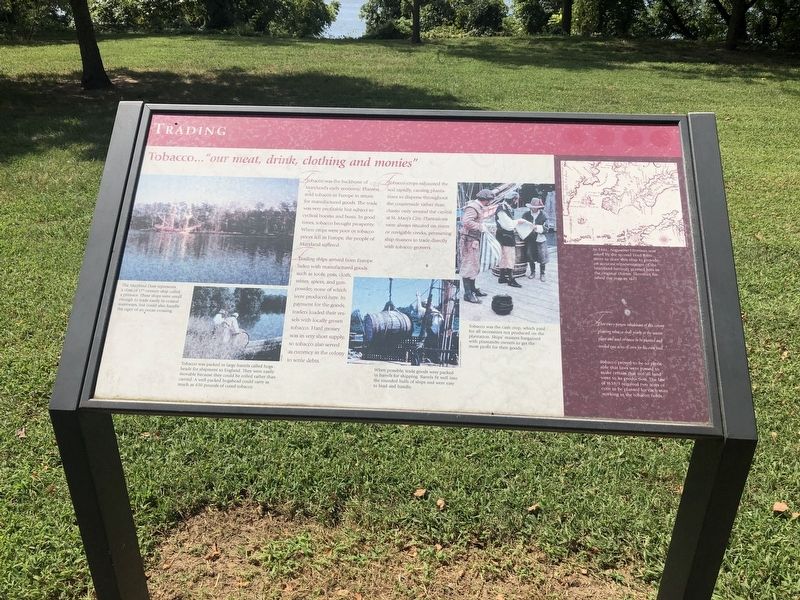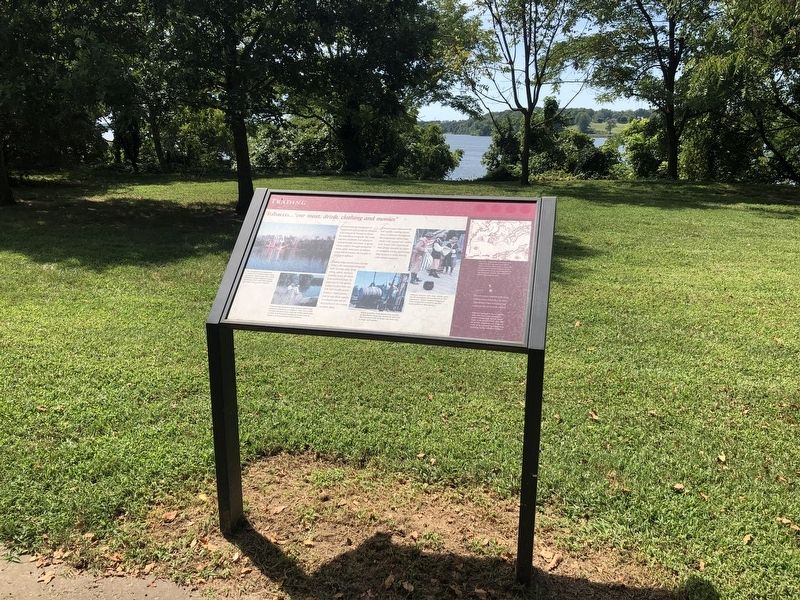St. Mary's City in St. Mary's County, Maryland — The American Northeast (Mid-Atlantic)
Tobacco... "our meat, drink, clothing and monies"
Trading

Photographed By Devry Becker Jones (CC0), August 30, 2019
1. Tobacco... "our meat, drink, clothing and monies" Marker
Trading ships arrived from Europe laden with manufactured goods such as tools, pots, cloth, wines, spices, and gunpowder, none of which were produced here. In payment for the goods, traders loaded their vessels with locally grown tobacco. Hard money was in very short supply, so tobacco also served as currency in the colony to settle debts.
Tobacco crops exhausted the soil rapidly, causing plantations to disperse throughout the countryside rather than cluster only around the capital at St. Mary's City. Plantations were always situated on rivers or navigable creeks, permitting ship masters to trade directly with tobacco growers.
[Captions:]
The Maryland Dove represents a class of 17th-century ship called a pinnace. These ships were small enough to trade easily in coastal waterways, but could also handle the rigor of an ocean crossing.
Tobacco was packed in large barrels called hogsheads for shipment to England. They were easily movable because they could be rolled rather than carried. A well-packed hogshead could carry as much as 450 pounds of cured tobacco.
When possible, trade goods were packed in barrels for shipping. Barrels fit well into the rounded hulls of ships and were easy to load and handle.
Tobacco was the cash crop, which paid for all necessities not produced on the plantation. Ships' masters bargained with plantation owners to get the most profit for their goods.
In 1661, Augustine Herman was asked by the second Lord Baltimore to draw this map to provide an accurate representation of the Maryland territory granted him in the original charter. Herman finished the map in 1671.
"That every person inhabitant of this colony planting tobacco shall yearly at the season plant and tend or cause to be planted and tended two acres of corn for his own food..."
Tobacco proved to be so profitable that laws were passed to make certain that not all land went to its production. The law of 1638/9 required two acres of corn to be planted for each man working in the tobacco fields.
Erected by Historic St. Mary's City.
Topics. This historical marker is listed in these topic lists: Agriculture • Colonial Era • Industry & Commerce • Settlements & Settlers. A significant historical year for this entry is 1661.
Location.

Photographed By Devry Becker Jones (CC0), August 30, 2019
2. Tobacco... "our meat, drink, clothing and monies" Marker
Other nearby markers. At least 8 other markers are within walking distance of this marker. A Busy Enterprise (a few steps from this marker); An Innovative Entrepreneur (a few steps from this marker); From Many Lands (a few steps from this marker); Meet Garrett Van Sweringen (a few steps from this marker); The Van Sweringen Family (a few steps from this marker); The Van Sweringen Site (a few steps from this marker); …Adjourn to the Arbour at Vansweringens (within shouting distance of this marker); Mathias de Sousa (within shouting distance of this marker). Touch for a list and map of all markers in St. Mary's City.
Additional keywords. Tobacco... "our meat, drink, clothing and monies"
Credits. This page was last revised on September 4, 2019. It was originally submitted on September 4, 2019, by Devry Becker Jones of Washington, District of Columbia. This page has been viewed 225 times since then and 30 times this year. Photos: 1, 2. submitted on September 4, 2019, by Devry Becker Jones of Washington, District of Columbia.